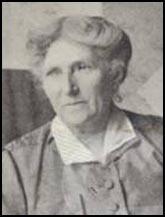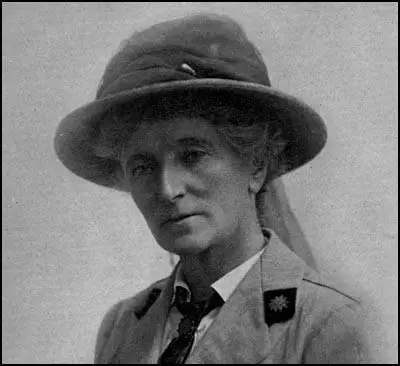Katherine Harley

Katherine French, the daughter of William French, a naval commander from Ireland, was born in 1855. By the age of ten her father had died and her mother was committed to an insane asylum and she was sent to London to live with relatives. She was the sister of Charlotte French and John French.
She married a soldier but he was killed in the Boer War. Katherine Harley joined the National Union of Suffrage Societies in 1910. She was also an active member of the Church League for Women's Suffrage. However, her sister, Charlotte Despard was a member of the more militant, Women's Social and Political Union and Women's Freedom League.
In 1913 the National Union of Women Suffrage Societies (NUWSS) had nearly had 100,000 members. Katherine Harley suggested holding a Woman's Suffrage Pilgrimage in order to show Parliament how many women wanted the vote. According to Lisa Tickner, the author of The Spectacle of Women (1987) argued: "A pilgrimage refused the thrill attendant on women's militancy, no matter how strongly the militancy was denounced, but it also refused the glamour of an orchestrated spectacle."
Members of the NUWSS set off on 18th June, 1913. The North-Eastern Federation, the North and East Ridings Federation, the West Riding Federation, the East Midland Federation and the Eastern Counties Federation, travelled the Newcastle-upon-Tyne to London route. The North-Western Federation, the Manchester and District, the West Lancashire, West Cheshire and North Wales Federation, the West Midlands Federation, and the Oxfordshire, Berkshire, Buckinghamshire and Bedfordshire Federation travelled on the Carlisle to the capital route. The South-Western Federation, the West of England Federation, the Surrey, Sussex and Hampshire Federation walked from Lands End to Hyde Park.
As Elizabeth Crawford, the author of The Suffragette Movement (1999), pointed out: "Pilgrims were urged to wear a uniform, a concept always close to Katherine Harley's heart. It was suggested that pilgrims should wear white, grey, black, or navy blue coats and skirts or dresses. Blouses were either to match the skirt or to be white. Hats were to be simple, and only black, white, grey, or navy blue. For 3d, headquarters supplied a compulsory raffia badge, a cockle shell, the traditional symbol of pilgrimage, to be worn pinned to the hat. Also available were a red, white and green shoulder sash, a haversack, made of bright red waterproof cloth edged with green with white lettering spelling out the route travelled, and umbrellas in green or white, or red cotton covers to co-ordinate civilian umbrellas."
Lisa Tickner has pointed out: "Most women travelled on foot, though some rode horses or bicycles, and wealthy sympathisers lent cars, carriages, or pony traps for the luggage. The intention was not that each individual should cover the whole route but that the federations would do so collectively." One of the marchers, Margory Lees, claimed that the pilgrimage succeeded in "visiting the people of this country in their own homes and villages, to explain to them the real meaning of the movement." Another participant, Margaret Greg, recorded: "My verdict on the Pilgrimage is that it is going to do a very great deal of work - the sort of work that has hitherto only been done by towns or at election times is being spread all over the country." The pilgrims were accompanied by a lorry, containing their baggage. Margaret Ashton brought her car and picked up those suffering from exhaustion.
An estimated 50,000 women reached Hyde Park in London on 26th July. As The Times newspaper pointed out, the march was part of a campaign against the violent methods being used by the Women Social & Political Union: "On Saturday the pilgrimage of the law abiding advocates of votes for women ended in a great gathering in Hyde Park attended by some 50,000 persons. The proceedings were quite orderly and devoid of any untoward incident. The proceedings, indeed, were as much a demonstration against militancy as one in favour of women's suffrage. Many bitter things were said of the militant women."
On 29th July 1913, Millicent Fawcett wrote to Herbert Asquith "on behalf of the immense meetings which assembled in Hyde Park on Saturday and voted with practical unanimity in favour of a Government measure." Asquith replied that the demonstration had "a special claim" on his consideration and stood "upon another footing from similar demands proceeding from other quarters where a different method and spirit is predominant."
On the outbreak of the First World War in 1914 Eveline Haverfield founded the Women's Emergency Corps, an organisation which helped organize women to become doctors, nurses and motorcycle messengers. Elsie Inglis, one of the founders of the Scottish Women's Suffrage Federation, suggested that women's medical units should be allowed to serve on the Western Front.

With the financial support of the National Union of Women's Suffrage Societies (NUWSS), Inglis formed the Scottish Women's Hospitals Committee. Soon satellite committees were formed in Glasgow, London and Liverpool. The American Red Cross also helped to fund the organisation. Although the War Office representative in Scotland opposed the idea, Dr. Elsie Inglis and her Scottish Women's Hospitals Committee sent the first women's medical unit to France three months after the war started. This included Katherine Harley. By 1915 the Scottish Women's Hospital Unit had established an Auxiliary Hospital with 200 beds in the 13th century Royaumont Abbey.
In April 1915 Elsie Inglis took a group of women, including Katherine Harley, to Serbia on the Balkan Front. Over the next few months they established field hospitals, dressing stations, fever hospitals and clinics. During an Austrian offensive in the summer of 1915, Inglis and some of her staff were captured but eventually, with the help of American diplomats, the British authorities were able to negotiate the release of the women.
In 1917, the 62 year-old Katherine Harley was killed by a shell in Serbia. According to Elizabeth Crawford, the author of The Suffragette Movement (1999): "She worked both in France and Serbia. Not an easy colleague, and not one happy to take orders, she was killed by a shell at Monastir, where, as one woman doctor laconically noted, she had no need to be."

